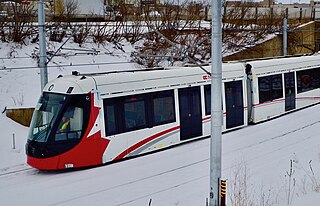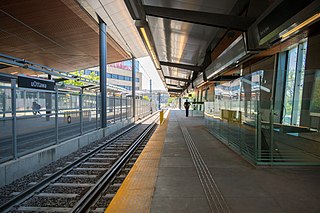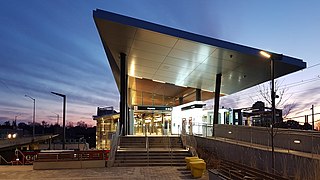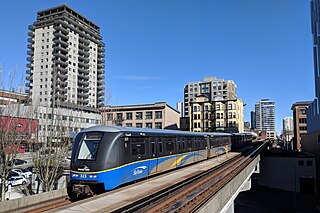
OC Transpo is the organisation that operates and plans public transport in the city of Ottawa. OC Transpo's system includes bus rapid transit, light rail, conventional bus routes, and door-to-door paratransit.

The Transitway is a bus rapid transit (BRT) network operated by OC Transpo in Ottawa, Ontario, Canada. It comprises a series of bus-only roadways and reserved lanes on city streets and highways. The dedicated busways ensure that buses and emergency vehicles on the Transitway rarely intersect directly with the regular traffic, and make it possible for them to continue at full speed even during rush hour. OC Transpo operates a network of rapid routes which use the Transitway to connect communities with the O-Train light rail system. Additional bus routes also use segments of the Transitway.

uOttawa is a light rail transit (LRT) station on the O-Train Confederation Line, located on the University of Ottawa campus.

Bayview is an O-Train interchange station in Ottawa, Ontario, Canada, connecting the Confederation Line and Trillium Line.

Greenboro is a transitway stop and future O-Train Trillium Line station in Ottawa, Ontario, Canada. It is located at Bank Street and Johnston Road at the north end of the South Keys shopping complex. The station has a 678-space paid park and ride lot. The bus terminus was opened with the southern transitway on September 2, 1995.

Carleton is an O-Train light rail station located in the center of the Carleton University campus in Ottawa, Ontario. The station is served by Line 2, which began service in 2001, and is between Dow's Lake station to the north and Mooney's Bay station to the south. The line and station are currently under construction, and are expected to reopen in the summer of 2024.

Tremblay is an O-Train station on the Confederation Line in Ottawa, Ontario which serves the Ottawa train station, connecting to Via Rail Corridor inter-city rail services and a daily Ontario Northland bus service to Sudbury and Sault Ste. Marie. The station opened on September 14, 2019 to replace the former Transitway bus rapid transit station known as Train Station.
The Chief William Commanda Bridge, formerly the Prince of Wales Bridge, is a pedestrian/cycling bridge and former rail bridge that spans the Ottawa River between Ottawa, Ontario and Gatineau, Quebec, Canada. It connects the Trillium Pathway in Ottawa to the Voyageurs Pathway in Gatineau. The bridge crosses the south channel of the river to Lemieux Island at the edge of Nepean Bay and continues across the northern channel into the Province of Quebec.

Tunney's Pasture is the western O-Train light rail terminal train station in Ottawa, Ontario.

South Keys station is the southernmost station of the Southeast Transitway in Ottawa. The station is located in the South Keys neighbourhood, behind the south end of the South Keys Shopping Centre, and between Bank Street and the Airport Parkway. The Transitway station was opened for bus service on September 2, 1995.
Airport is an under construction O-Train rapid transit station. It will be located at the Ottawa Macdonald–Cartier International Airport in the south end of Ottawa. Estimated for completion in 2024, it will serve as the southern terminus of the three-stop Line 4. The airport is currently served by an OC Transpo bus stop.

Light rail is a commonly used mode of public transit in North America. The term light rail was coined in 1972 by the Urban Mass Transportation Administration to describe new streetcar transformations which were taking place in Europe and the United States. The Germans used the term Stadtbahn, which is the predecessor to North American light rail, to describe the concept, and many in UMTA wanted to adopt the direct translation, which is city rail. However, in its reports, UMTA finally adopted the term light rail instead.
Jeanne d'Arc station is a stop on Ottawa's Transitway. It is located at the interchange of Regional Road 174 and Jeanne d'Arc Boulevard in Orléans in the east end of the city of Ottawa.

Fallowfield station or Fallowfield Train Station is an inter-city passenger railway station and bus rapid transit station located at 3347 Fallowfield Road in the suburban neighbourhood of Barrhaven in Ottawa, Ontario, Canada.

The Confederation Line, also called O-Train Line 1, is a light rail line operated by OC Transpo in Ottawa, Ontario, Canada, as part of the city's O-Train light rail system. It opened on September 14, 2019, and is O-Train's second line. It operates on an east–west route, with a segment under Queen Street in the downtown core, complementing the north–south Trillium Line that operates to the west of the downtown core. Using light rail rolling stock and technology, the Confederation Line is completely grade separated.

The O-Train is a light rail rapid transit system in Ottawa, Ontario, Canada, operated by OC Transpo. The O-Train system has two lines, the electrically-operated Confederation Line and the diesel-operated Trillium Line. Since May 2020, Stage 2 construction has temporarily shut down Line 2, with replacement bus service being offered at all stations. When Line 2 reopens in 2024, it will extend southward to Limebank station and incorporate five newly constructed stations, as well as an additional line linking Line 2 to Ottawa International Airport which will replace the current bus service from route 97. By 2026, expansions along Line 1 and the construction of Line 3 stations in the west end are expected to be complete, bringing the system's length to 64.5 km (40.1 mi), four lines and 41 stations. The O-Train network is fully grade separated and does not have any level crossings with roads.

The Alstom Citadis Spirit is a low-floor articulated light rail vehicle developed by Alstom for Ottawa's O-Train. It is marketed as part of its Citadis family, which includes other models of light rail vehicles, and is based on the Citadis Dualis.

Urban rail transit in Canada encompasses a broad range of rail mass transit systems, including commuter rail, rapid transit, light rail, and streetcar systems.
Limebank is an under construction terminal station on the Trillium Line in Ottawa, Ontario. When constructed, it will be the southern terminus of the Stage 2 O-Train expansion and is scheduled for completion in 2024. The station will be elevated with two side platforms and is located southwest of the intersection of Limebank and Earl Armstrong roads. OC Transpo Rapid bus routes 74 and 99 will connect to this station once revenue service begins in 2024.


























